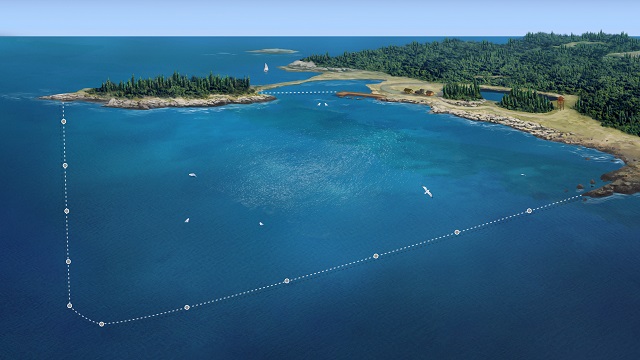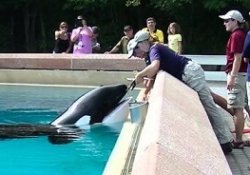What the “Free Willy” whale tells me about creating a sanctuary for captive whales and dolphins
By Charles Vinick, Executive Director, the Whale Sanctuary Project
I’m sitting on the wharf, here at Port Hilford Bay, and behind me are 100 acres of water space that are going to be a sanctuary for captive whales. And I’m reminded of the times I spent in Iceland with Keiko, the “Free Willy” whale.
We’d brought him back from a marine entertainment park to the ocean where he’d been born some 20 years earlier. And we’d created a temporary sanctuary for him in a 15-acre netted-off bay, much smaller than the size of what we have here.
That’s how big this sanctuary is, and that’s what it means to give them back their freedom in nature.Once Keiko was in the water, he would swim across it and chase birds. And if there was rough weather, he’d just lift his head and the waves and the wind would come into his face and you could see and feel how he seemed to be just loving it. He was in his natural environment.
And it’s that same experience that I picture here. We’ll have whales in these waters, and they’ll be able to chase birds across the bay. They’ll be able to play in the water. They’ll have waves and all kinds of weather. And they’ll be exuberant.
That’s what you never see in a concrete tank at an entertainment park. You don’t see the whales living their own lives in their own natural environment. You only see them doing what they’re told to do. And what they have to do.
And that’s completely different from what the whales will have here at the sanctuary.

Here they’ll be able to choose whether they dive, whether they swim across the whole 100 acres. If one of our whales is all the way out at the far end of the perimeter, we’ll barely see them from here. That’s how big this sanctuary is, and that’s what it means to give them back their freedom in nature.
Of course, we’ll take care of them with food and with whatever medical care they need. But they’ll decide how they spend their time. And they’ll be spending it in nature.

Kiska, the lone orca at Marineland Canada
Think about Kiska for a moment. She’s the solitary orca at Marineland. And the pictures we’ve seen of her are not good. We’ve seen her slamming her body against the side of the tank, over and over. It’s like if you or I were in solitary confinement, pacing back and forth endlessly. It’s the same kind of thing that happens with whales when they’re confined in a tank.
Of course, we don’t yet know whether we can bring Kiska here. That’s not up to us. Right now, she’s basically “owned” by a marine entertainment park, a private company.
Right now, Kiska’s situation is urgent, and so is the situation for all the other whales at Marineland. The reports we hear every day – many of them from people like you who have sent us photos and video – is very troubling.
But we’re confident that working with Marineland or with the government or both, we can find a solution so that she can begin a new life in a natural environment.
And we think of the belugas, too, who are at Marineland. And of orcas and belugas in other entertainment parks, where the owners are trying to figure out what they should do next.
A new home for whales that can make up for so much of what has gone before.So, we know that there is growing interest from all over the world. And that’s why I’m asking you to help us build this sanctuary.
Together, we can do this. And your donation is the key to bringing it about.
This year, we have completed a comprehensive professional evaluation of the sanctuary site – the water quality, the tidal flows, the plant and animal life – to ensure that the bay will be a good home for the whales and that we can maintain the high quality of the marine environment. And we’re well advanced in our review processes with federal, provincial and local authorities.
Next year, 2022, is the year we create the sanctuary itself: a new home for whales that can make up for so much of what has gone before. A home where they can be in nature. As they’re meant to.
Thank you for your support of this unique project.